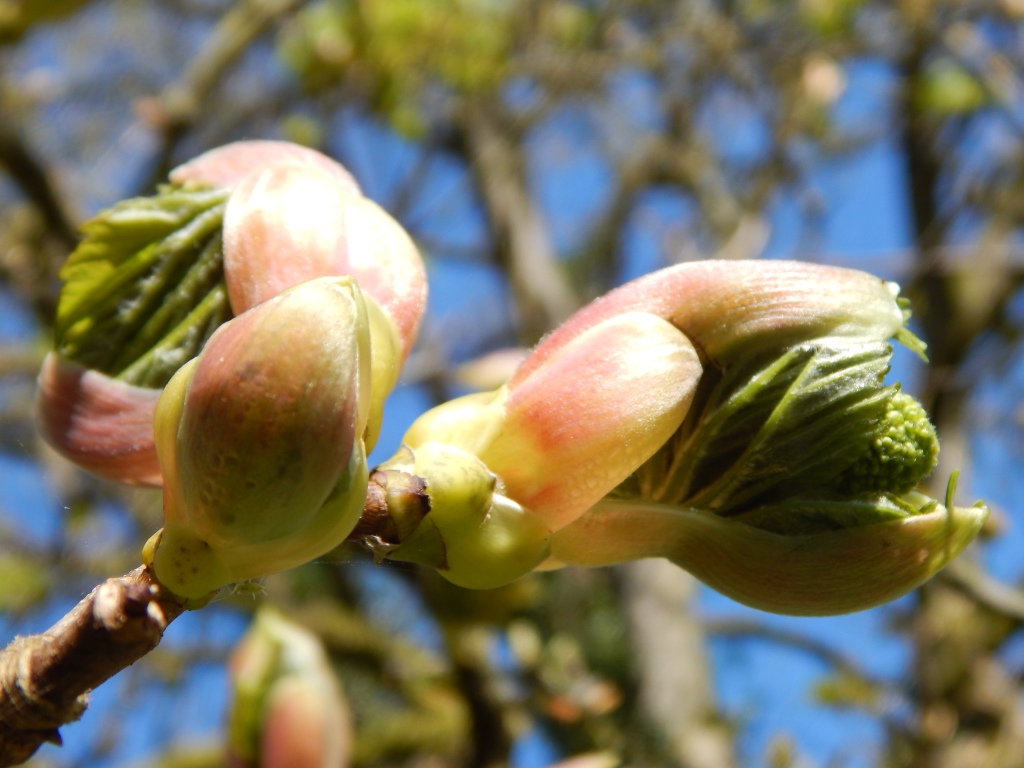
[008] Aesculus hippocastanum, Horse-chestnut
Introduction
Aesculus hippocastanum, the Horse-chestnut is a large, widespread and common, deciduous tree, well-known for its familiar leaves and the conkers it produces in the Autumn. In Britain it is now regularly blighted by Cameraria ochridella, the Horse-chestnut Leaf-miner.
It is also commonly known as a conker tree.
Taxonomy
Kingdom – Plants
Division – Vascular Plants
Class – Flowering Plants
Order – Sapindales
Family – Sapindaceae (Soapberries)
Genus – Aesculus (Buckeyes and Horse-chestnut}
Scientific Name – Aesculus hippocastanum
Name
The genus Aesculus, which we met yesterday, is split between American species called buckeyes and Eurasian species called horse-chestnuts. The name horse-chestnut comes from the fact that its leaves and fruits are visually very similar to the Sweet Chestnut, [069] Castanea sativa, although the two are in different families. There was an alleged observation that the fruit or seeds could help panting or coughing horses.
The fruit of the buckeyes do not look similar to the Sweet Chestnut.
You will have read about the name Aesculus yesterday. Hippo-castanum is a mixture of Greek and Latin for horse-chestnut.
If you thought you knew where the word conker came from, you were probably wrong. It comes from an old dialect word for snail-shells because the game of conkers originally used snail-shells!
Description
We saw the buckeyes Aesculus flava and Aesculus pavia yesterday and Aesculus hippocastanum is quite similar to both. It is a much larger tree, with larger leaves of five or seven long leaflets.
My problem with early flowering species that come early in the alphabet is that I may not have pictures taken in early Spring. Fortunately, from a previous blog I have some pictures of the emerging buds of this tree. The leaves and flowers come out at the same time around mid-April.





The next picture from a few days later just shows the emerging white flowers in vertical ‘panicles’ like the buckeyes, while the fresh leaves haven’t quite spread out fully.

Its fruit, known as conkers, are very similar to the buckeyes but, unlike them, they come in shells protected by spikes.



Habitat and use
Aesculus hippocastanum is native to a few very small areas in Northern Greece and Albania but has been cultivated in much of Europe and is naturalized in Britain. It is widely used as an ornamental tree.
The fruit are used in the game of ‘conkers,’ which I am sure is familiar to you.
Other Notes
Cameraria ochridella, the Horse-chestnut Leaf-Miner is a micro-moth that was first seen and identified in North Macedonia in 1984. It took about ten years to spread to an area of central Europe and has continued its expansion, gradually and slowly, not crossing the English Channel until this century. It has now spread to most of Britain and almost every tree you see will be covered in them.
The larvae live inside the leaves of the Horse-chestnut tree and leave brown marks as they eat it away inside. Thousands of them may turn all of the leaves brown but the tree survives relatively unharmed. They can get through from three to five generation in a year. Hibernating pupae are able to survive heavy frosts. They reinfest every year, which is why the fresh leaves in the pictures above are green and undamaged.

If you look carefully the picture above has a moth in the centre.

See also
The closely related buckeyes were considered yesterday in [007].
We will have a few more trees!

Pingback: [212] Liriodendron tulipifera, Tulip Tree | The Species of Britain
Pingback: [342] Trachycarpus fortunei, Chusam Palm | The Species of Britain